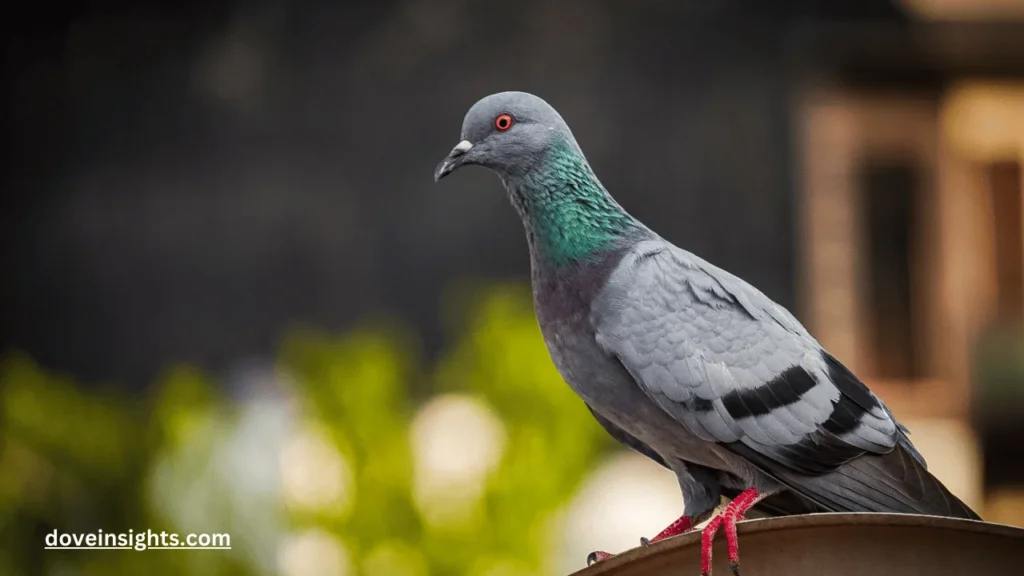When you see a dove taking flight, you may notice a unique, soft, yet distinct sound that accompanies their graceful movement.
This noise, often compared to a gentle whistle or a soft whoosh, is an intriguing aspect of dove behavior that many people wonder about. While doves are usually associated with peace and tranquility, the noise they make during flight is anything but quiet. In fact, it’s a noticeable characteristic that sets them apart from many other birds.
Why do doves make noise when they fly? The answer may surprise you, as this seemingly simple sound plays a critical role in their communication, aerodynamics, and even survival.
Understanding why doves create noise while flying requires delving into their biological anatomy, behavioral patterns, and the purpose behind the sound.
This article will explore the various reasons behind this phenomenon, offering insights into how doves use sound to communicate with one another and how their physical traits contribute to the sound they produce.
By examining these factors, we can gain a deeper appreciation for the dove’s flight mechanics and how such seemingly minor traits are essential to their survival and behavior.
Whether you’re a birdwatching enthusiast or simply curious about these beautiful creatures, understanding the reasons for the noise doves make during flight is both fascinating and revealing.
While many birds are silent when they take to the sky, doves’ flight noises aren’t just random—they serve a purpose.
From the flutter of their wings to the specific sounds that help them communicate with their mates or warn other birds, these noises offer valuable clues about how doves interact with the world around them.
So, if you’ve ever wondered what makes the soft whistle or whoosh of a dove so unique, keep reading to discover the fascinating reasons behind this sound.
Contents
- 1 The Anatomy of a Dove’s Wing and Its Impact on Sound Production
- 2 Communication Through Flight: The Role of Sound in Dove Behavior
- 3 Wing Shape and Flight Mechanics: How Doves Use Sound for Flight Stability
- 4 The Effect of Environmental Factors on Dove Flight Noise
- 5 Evolutionary Significance:
- 6 Conclusion:
- 7 FAQ’s
- 7.0.1 Is the noise doves make during flight unique to them?
- 7.0.2 Does the noise indicate the dove’s size or age?
- 7.0.3 Do doves always make noise when they fly?
- 7.0.4 Can doves make noise without flying?
- 7.0.5 Do doves make noise during all types of flight?
- 7.0.6 Do doves make noise when they are startled?
The Anatomy of a Dove’s Wing and Its Impact on Sound Production
One of the primary reasons doves make noise when they fly is tied to the structure of their wings. Unlike many other birds, doves have broad, long wings designed for swift but controlled flight.
The flapping motion of these wings creates a disturbance in the air as they move, which leads to the distinctive sound associated with their flight. Specifically, when a dove flaps its wings, it displaces air in a way that causes a whistling or whooshing noise.
The sound is produced by the airflow over the wings and through the feathers. Doves have a specialized wing structure that helps them maintain stability and control during flight, but this same structure also contributes to the noise they make.
As the wings slice through the air, the feather tips vibrate, and the air movement creates a whistle or a soft rush of wind, which is more pronounced when the bird is flying at higher speeds or through turbulent air.
This aerodynamic phenomenon is not exclusive to doves but can be observed in many birds with similar wing shapes.
However, because doves are often seen flying at medium altitudes and in a relatively slow, steady pattern, the sound they produce is more noticeable compared to faster, high-flying birds like hawks or eagles.
Communication Through Flight: The Role of Sound in Dove Behavior
While the noise doves make during flight is partially a result of their wing structure, it also plays an important role in communication. Doves are social creatures that often live in flocks, and their flight noise can serve as a way to communicate with others in their group.
The whistles and whooshes produced by their wings may act as a signaling mechanism, alerting other doves to their location, movement, or flight direction.
In situations where doves are in dense vegetation or areas with low visibility, the sound helps them stay connected with the flock. Doves are known to be very sensitive to auditory signals, and they can quickly react to the sounds made by others in their group.
For example, the noise produced by a dove during takeoff might help other members of the flock maintain coordination or avoid collision, especially in tight spaces.
Moreover, flight noise can serve a territorial function. Male doves may produce louder or more pronounced sounds while flying as part of their courtship rituals.
This may help them attract mates by showcasing their strength, agility, or dominance over other males. In this way, the noise during flight becomes a critical part of dove behavior, not just in communication but in maintaining relationships within the flock.
Wing Shape and Flight Mechanics: How Doves Use Sound for Flight Stability
A lesser-known reason why doves make noise when they fly is related to the mechanics of flight. The wing shape and size of a dove play a significant role in the efficiency and stability of its flight.
Doves are capable of rapid acceleration and often use their flight noise to maintain control over their movements, particularly when taking off or changing direction.
The noise generated by their wings during flight can help stabilize their flight patterns. As doves flap their wings, the sound produced may act as a feedback mechanism, allowing the bird to make subtle adjustments to its flight.
For instance, the rush of air through the wings can signal if the bird is flying at an optimal speed or if adjustments are needed to prevent stalling or losing balance.
Doves use their wings not just for lift but also for maneuverability. The combination of sound and movement allows them to quickly navigate through complex environments, such as forests or urban areas, where sudden changes in direction are often necessary.
The noise helps the bird assess the airflow around its wings and make the required adjustments for a safe and smooth flight.
The Effect of Environmental Factors on Dove Flight Noise
Environmental factors such as wind speed, temperature, and air density can also affect the sound that doves make during flight. For instance, on a windy day, the noise may become louder or more pronounced because the increased airflow causes the wings to cut through the air more forcefully.
Similarly, during colder weather, the density of the air can change, which may also impact how the sound travels.
Doves are highly adaptable and can adjust their flight techniques based on the weather conditions. For example, in strong winds, doves may fly with a more steady and controlled wing beat, producing more noticeable noises as a result.
In contrast, on calm days, the sound may be softer or barely perceptible.
Moreover, urban environments also play a role in how the sound is perceived. In cities with high-rise buildings, the echoes can make the noise of doves’ wings seem amplified or distorted.
Doves in such areas may also produce more noise due to the dense air around the buildings, which can impact their flight mechanics and the resulting sounds.
Evolutionary Significance:

From an evolutionary standpoint, the development of flight-related sounds in doves likely provided significant survival advantages.
Early doves that made noise during flight could have communicated more effectively, aiding in flock cohesion and the ability to evade predators. The noise may have acted as a deterrent to potential threats, signaling the presence of a group of birds that are capable of flying away quickly.
Additionally, the ability to communicate via sound during flight could have been vital during the breeding season, when male doves often need to compete for mates. The loudness or frequency of flight noise could indicate strength or fitness, making it an important signal for attracting females.
Thus, the flight noise serves not only for practical purposes like navigation and communication but also plays a key role in the evolutionary success of doves.
Conclusion:
The noise that doves make while flying may seem like a small, inconspicuous detail, but it plays an important role in their communication, flight mechanics, and survival strategies. From the structure of their wings to their social interactions, these sounds are not random—they are part of a complex system that helps doves navigate the world around them.
Whether it’s helping them stay coordinated in a flock, attracting a mate, or simply maintaining flight stability, the noise produced by doves is far more than just a byproduct of flight; it is an essential aspect of their behavior and adaptation.
Next time you hear the gentle whoosh of a dove flying overhead, take a moment to appreciate the evolutionary benefits of this seemingly subtle trait.
It’s a reminder that in nature, even the smallest details serve a larger purpose, helping animals like doves thrive in their environment.
FAQ’s
Is the noise doves make during flight unique to them?
No, while the sound doves make during flight is quite distinctive, it’s not unique to them. Many birds with broad, long wings—such as hawks, owls, and pigeons—also produce audible noises during flight. However, doves’ wingbeats tend to generate a softer, more whistling sound, which makes their flight noise more noticeable and characteristic. The specific structure of doves’ wings and the way they use them for flight make the noise they produce different from that of other birds.
Does the noise indicate the dove’s size or age?
Generally, the size or age of a dove doesn’t significantly impact the noise it makes during flight. The primary factor in the sound produced is the dove’s wing structure and the speed at which it flies. However, older or larger doves may create slightly louder noises due to stronger wing beats or more forceful flight, but these differences are subtle. What is more important is the bird’s flight technique and environmental factors that influence the noise.
Do doves always make noise when they fly?
While doves often make noise when they fly, they don’t always do so. The sound is more noticeable when they are taking off, flying rapidly, or changing direction quickly. In calmer conditions, such as when they are flying slowly or gliding, the noise may be less prominent or almost nonexistent. Additionally, some doves may produce quieter sounds depending on the environment, such as in densely vegetated areas where the noise can be absorbed by surrounding trees or foliage.
Can doves make noise without flying?
Yes, doves are capable of making noise when they are not in flight. They are well known for their cooing sounds, which they use to communicate with other doves, especially during mating seasons or territorial disputes. However, the sound produced during flight is distinct and typically caused by the airflow over their wings. This noise is different from the usual cooing noises made by doves while perched or resting.
Do doves make noise during all types of flight?
Doves produce more noise during certain types of flight. For example, during takeoff, rapid acceleration, or direction changes, the air turbulence generated by their wings results in a more pronounced sound. When they are gliding or flying at a steady pace without rapid wing movements, the sound is often less noticeable. Therefore, the type of flight—whether it’s fast and erratic or slow and steady—determines how much noise is generated.
Do doves make noise when they are startled?
Yes, doves may produce a noise when they are startled and take flight quickly. This often happens when they are startled by a predator or a sudden disturbance. The noise in this case is a byproduct of the rapid, forceful flapping of their wings as they escape the threat. This quick takeoff creates a distinctive sound that can be heard from a distance.








